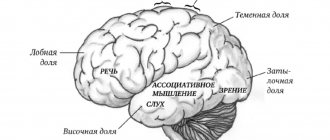It is difficult to imagine the existence of people without interpersonal communication. Human life is made up of situations that involve other people, and the quality of our interactions with others affects the quality of our lives.
We can confidently say that interpersonal relationships are a science that reveals in detail the world of communication between people and its influence on us. Each person has his own schema for perceiving other people, such schemas are called interpersonal perceptual effects.
In this article:
How we perceive another person The effects of impressions and their influence on communication What is your pattern of cognition of another person
Effects of stereotyping
Our perception tends to classify people into groups: simpletons, smart people, bandits, fools. Having knowledge of how bandits behave, you do not have to personally communicate with them to understand who they are. In this case, stereotypes make life easier for many people, but they do not take into account exceptions to the rules.
Prejudice effect
It works like this: people see what they believe in, but do not pay attention to the contradictions in their picture.
Halo effect
A person who is presented in a favorable light, many people think only good things about him and vice versa. Under the influence of the halo effect, the general opinion about a person is transferred to all other areas of his life. Show business stars can be a striking example.
Causal attribution effect
Manifests itself in explaining the words or actions of another person through one’s own prism of perception. There are several types of causal attribution:
- Cultural bias.
The behavior of another person is assessed based on his cultural characteristics. For example, many people are sure that the Japanese are workaholics.
- Characteristic attribution.
Attributing certain characteristics to a person based on the first impression. For example, a doctor was rude to you. Thus, you will be convinced that he has a bad character, your verdict is that the doctor is an evil (unpleasant, bad) person.
Authority effect
A Russian teacher can convince a person that he is more illiterate than his friend or colleague. When choosing to buy toothpaste, you'd rather listen to your dentist than your mom.
What is your pattern of knowing another person?
Now, knowing about the effects of perception, you can safely control and track them, this will help you more accurately form an image about a new person and build relationships that are safe, first of all, for yourself.
You can test yourself through personal introspection and constant training. Wherever you are, you can do this, for example, in a store, when you look at the seller and observe his behavior and manner of speaking, public transport is generally full of strangers, you should be more observant and, based on situations, ask yourself questions:
- “Fatigue on a woman’s face, what is she talking about?”
- "Where can he go?"
- “For what reason is a person dressed so smartly?”
- “Why does he brazenly and openly look at everyone?” etc.
Of course, the answers are speculative, but such training will allow you to develop and expand your own capabilities in knowing other people. You will develop an automatic assessment of the maximum number of indicators and signals that will be truthful.
By getting to know yourself and knowing your own projections through which you look at the people around you, it will become simple and easy for you to see their true traits and characteristics, and not use substitute concepts.
You should not be afraid to be a true observer, you need to ask yourself questions and stop your imagination in time. Not all people with a pleasant appearance and a calm voice are kind, and not all thin people are angry and nervous. It’s worth learning this yourself and teaching your children, because it will help you be attentive and protected.
Sequence Effects
People perceive any new information based on the information that preceded it. This effect can be observed at work, master classes, and educational institutions.
Primacy effect
In other words, people overestimate the first impression. Because they believe that it is true, and the future attitude towards the person depends on it.
Novelty effect
You can talk for a long time and a lot about a person, but what will be remembered best is the fact that they did not expect from the person.
Repetition effect
The more often the same message is repeated, the more likely it is that people will believe what is happening. Many people think: “If everyone is talking about it, it means it’s true.”
Mechanisms of interpersonal perception
It is customary to distinguish two groups of mechanisms by which people perceive each other:
- interpersonal,
- group.
The basic or most common mechanisms of interpersonal perception are considered to be:
- Identification .
We are talking about a person’s ability to perceive another, while drawing analogies with himself. This is the most accessible way of understanding, which does not require any effort from the individual, since such an assessment often occurs at the level of the unconscious. - Empathy . The ability to enter into the position of another person and feel his emotional state, as well as experiences.
- Decentration . The ability to step back from what is happening in order to evaluate situations from the outside, while getting used to the role of an outside spectator, for whom each side is alien and there is no moment of bias. It is this mechanism that is considered the most preferable for knowing another person, since it does not imply bias.
- Social reflection. A person’s ability to imagine and comprehend the impression he leaves of himself in the process of interpersonal interaction.
At the same time, the “depth” of reflection depends on how significant the interlocutor appears in the eyes of a person. - Attraction . A form of perception based on obvious sympathy for another person. Sympathy can manifest itself at three levels: direct sympathy, friendship and love. Among the factors that stimulate attraction are geographic proximity, similarity of views, and external attractiveness.
- Casual attribution. The ability of a person to look for reasons for his own behavior, as well as the behavior of his interlocutor. The attribution mechanism is activated at the moment when one of the interlocutors does not have enough facts to create a portrait of the interaction partner.
Technology of perception development
Perception creates a picture of reality based on the activity of an entire system of brain analyzers. The process of perception is physiological. Soviet psychologists L. Vygotsky and A. Zaporozhets talk about motor skills and vision as important factors in the development of perception. Eye movement plays an important role in the development of visual perception.
A fixed eye cannot perceive objects as a whole. With kinesthetic perception, connections arise, including space and time. With this type of perception, the reverse process occurs, providing control over the hands, which perform a variety of actions: from micro-movements to modeling.
For a person, the first significant changes in the perception of the world and perceptual actions occur in the first years of life. One of the decisive roles is played by sensory perception; from childhood, the accumulation of ideas about the color palette, shape, properties and size of surrounding objects begins.
Development technologies can be very diverse. Educational games that bring actions to automaticity, for example, comparing quantities through game manipulations, in which new information is learned. Gradually, the comparison of figures turns into visual perception, and the movements of the hands become more complex, and the sense of touch is involved.
Active search actions and the formation of connections between vision, hearing and touch make it possible to perceive complex signals, distinguish them, build connections, recognize and interpret.
Thus, not only is perceptual development important in its own right, but it is also an example of behavioral and neural plasticity—powerful mechanisms that can support developmental changes in many areas, beginning in early life.
Errors
There are many common perceptual errors that have a major impact on impression formation.
most common ones include:
- we fall under the influence of evidence,
- we are influenced by first impressions,
- we perceive the interlocutor through comparison with ourselves and look for similarities,
- we place more emphasis on negative character traits than on positive ones,
- when our interests suffer, we tend to blame people rather than circumstances.
Under the influence of certain effects, false ideas about the interlocutor are formed.
Errors of perception can be an incorrect interpretation of the reasons, motives and incentives of the interlocutor. It may also be a misunderstanding of the meaning of the words he said and the actions he performed.
If the interlocutor put a certain essence into his statement, and the one to whom this statement was intended could not understand this essence, we can talk about a perception error.
In some cases, perceptual errors are not directly tied to the interaction.
For example, based on appearance or stereotypes existing in society, a person may attribute qualities to a person that he does not possess. A person can also ignore some of the interlocutor’s qualities (both good and bad).
Classification of types of perception
1) Separation by modality: - visual perception; - auditory perception; - tactile perception; - taste perception; - olfactory perception. Combinations of different types of perception are possible.
2) Division by object of perception: - perception of space (includes the perception of size, shape, relative position of objects, their relief, distance and direction); — perception of time (reflection of the duration and sequence of phenomena or events); — perception of movement (reflection of the direction and speed of the spatial existence of objects); — perception of speed; - perception of direction; - perception of a work of art; - perception of the main phenomena of human life.
3) Separation by goal: - intentional (voluntary) perception (we are guided by a previously set goal or task); - unintentional (involuntary) perception (lack of volitional activity and purpose).
4) Division according to the participation of other psychological formations: - emotional perception (perception associated with emotions and feelings); — rational perception (perception subordinate to the thinking process).
The idea of another person is closely related to the level of one’s own self-awareness. Analysis of self-awareness through another person is carried out using two concepts: identification and reflection.
Identification is one of the mechanisms of cognition and understanding of a person, which consists in unconsciously likening oneself to a significant other.
Here, a significant other is a person who is an authority for a given subject of communication and activity. This usually happens when, in real interaction situations, an individual attempts to put himself in the place of a communication partner. During identification, a certain emotional connection is established with the object.
Developmental Assessment Find out more
It is necessary to distinguish between the concepts of “identification” and “reference”. If for the first concept the basis is the process of assimilation of the subject to a communication partner, i.e. assimilation to a significant other, then for the second concept (“reference”) the main thing is the subject’s dependence on other people, acting as a selective attitude towards them. The object of reference relations can be either a group of which the subject is a member, or another group with which he relates himself without being a real participant. The function of a referent object can also be performed by an individual person, including one who does not really exist (a literary hero, a fictional ideal to follow, etc.). In both cases, the subject borrows for himself goals, values, ideas, norms and rules of behavior of the object of reference (group, individual.
The concept of “identification” is close in content to the concept of “empathy”.
Empathy is the understanding of a person’s emotional states in the form of empathy. The mechanism of empathy is similar to the mechanism of identification.
This similarity lies in the ability to put oneself in the place of another, to look at things from his point of view. However, this does not necessarily mean identifying with that other person (as identification does). Simply, with empathy, the partner’s line of behavior is taken into account, the subject treats him with sympathy, but interpersonal relationships with him are built based on the strategy of his line of behavior.
Reflection is the individual’s awareness of how he is perceived by his communication partner, that is, how his communication partner will understand me.
During interaction, certain characteristics of each other are mutually assessed and changed.
Effects of Interpersonal Perception
Causal attribution
People, getting to know each other, are not limited to obtaining information through observation. They strive to find out the reasons for the behavior of communication partners and clarify their personal qualities. But since information about a person obtained as a result of observation is most often insufficient for reliable conclusions, the observer begins to attribute probabilistic causes of behavior and characterological personality traits to the communication partner. This causal interpretation of the behavior of the observed individual can significantly influence the observer himself.
Thus, causal attribution is the subject’s interpretation of the interpersonal perception of the causes and motives of other people’s behavior. The word "causal" means "caused". Attribution is the attribution of characteristics to social objects that are not represented in the field of perception.
see also
I myself am happy to be deceived...
Based on a study of problems associated with causal attribution, researchers have concluded that attributional processes constitute the main content of interpersonal perception. It is significant that some people tend to fixate physical traits to a greater extent in the process of interpersonal perception (in this case, the scope of “attribution” is significantly reduced), others perceive predominantly the psychological character traits of others. In the latter case, a wide scope for attribution opens up.
A certain dependence of “attribution” on the attitude in the process of perceiving a person by a person has been revealed. This role of attribution is especially significant when forming a first impression about a stranger. This was revealed in the experiments of A.A. Bodaleva. Thus, two groups of students were shown a photograph of the same person. But first the first group was told that the man in the photograph shown was a hardened criminal, and the second group was told about the same person that he was a prominent scientist. After this, each group was asked to create a verbal portrait of this person. In the first case, the corresponding characteristics were obtained: deep-set eyes testified to hidden anger, a prominent chin - to the determination to “go to the end in a crime,” etc. Accordingly, in the second group, the same deep-set eyes spoke of deep thought, and a prominent chin — about willpower in overcoming difficulties on the path of knowledge, etc.
Such studies should answer the question about the role of the characteristics given to communication partners in the process of interpersonal perception, and the degree of influence of attitudes on these characteristics.
Halo effect (halo effect)
Forming an evaluative impression of a person in conditions of a lack of time to perceive his actions and personal qualities. The halo effect manifests itself either in the form of positive evaluative bias (positive halo) or negative evaluative bias (negative halo).
So, if the first impression of a person is generally favorable, then in the future all his behavior, traits and actions begin to be reevaluated in a positive direction. In them, only positive aspects are highlighted and exaggerated, while negative ones are underestimated or not noticed. If, due to the prevailing circumstances, the general first impression of a person turns out to be negative, then even his positive qualities and actions in the future are either not noticed at all or are underestimated against the backdrop of hypertrophied attention to shortcomings.
Effects of novelty and primacy
Closely related to the halo effect are the effects of novelty and primacy. These effects (novelty and primacy) are manifested through the significance of a certain order of presentation of information about a person to form an idea about him.
The novelty effect occurs when, in relation to a familiar person, the most significant is the latest, i.e., newer information about him.
see also
Stereotypes about generational differences or how to approach any employee
The primacy effect occurs when, in relation to a stranger, the first information is more significant.
All the effects described above can be considered as special cases or variants of the manifestation of a special process that accompanies the perception of a person by a person, called stereotyping.
Stereotyping
Perception and evaluation of social objects based on certain ideas (stereotypes). Stereotyping is the attribution of similar characteristics to all members of a social group without sufficient awareness of the possible differences between them.
A stereotype is a simplified, often distorted, idea of a social group or an individual belonging to a particular social community, characteristic of the sphere of everyday consciousness.
A stereotype arises from limited past experience as a result of the desire to draw conclusions based on insufficient information. Most often, stereotypes arise regarding a person’s group affiliation.
Stereotyping is one of the most important characteristics of intergroup and interpersonal perception and is accompanied by manifestations of social attitudes, halo effects, primacy and novelty. In interpersonal perception, stereotyping performs two main functions:
1) maintaining identification;
2) justification of possible negative attitudes towards other groups.
Particularly widespread are the so-called ethnic stereotypes, when, based on limited information about individual representatives of certain ethnic groups, preconceived conclusions are drawn about the entire group. Stereotyping in the process of people getting to know each other can lead to two different consequences. On the one hand, to a certain simplification of the process of knowing another person, and then this simplification leads to the replacement of the image of a person with a cliche, for example, “all accountants are pedants,” “all teachers are supervisors.” On the other hand, this leads to prejudice if a judgment about a social object is based on limited past experience, which most often may turn out to be negative.
Attraction
When people perceive each other, certain relationships are formed with the inclusion of emotional regulators - from rejection of a particular person to sympathy, friendship, love.
Social attraction is a special type of social attitude towards another person, in which positive emotional components predominate.
There are three main levels of attraction: sympathy, friendship, love. Attraction manifests itself in emotional appeal, the attraction of one person to another.
Mutual understanding of communication partners presupposes that each of them knows the psychology of the other person: his value orientations, motives and goals of activity, the level of aspirations and attitudes, character traits, etc. People have varying degrees of ability to communicate and to develop interpersonal sensitivity. These abilities can be developed and improved in the process of conducting socio-psychological training on interpersonal sensitivity. Currently, in the practice of foreign psychology, so-called T-groups are organized (T is the initial letter of the word “training”), in which interpersonal sensitivity training is carried out. Social and psychological trainings are organized using sensitive methods. The sensitive method belongs to the category of interpersonal sensitivity methods. The main goal of sensitivity training is to develop and improve the ability of individuals to understand each other.
Participants should not previously know each other. When forming a group, there is no attempt to structure it based on education, position, qualifications or profession. During such training, participants are included in a completely new sphere of social experience for them, thanks to which they learn how they are perceived by other group members and have the opportunity to compare these perceptions with self-perception.
- Tweet
Gender characteristics of perception
Perception in psychology is the acceptance of people of different sexes and genders, their appearance characteristics, outlook on life, experience and knowledge. The concept of gender describes a person’s status, his social perception; it is a kind of social gender.
Gender stereotypes are widespread in society and are essentially recognized as social norms for both sexes. There is also a division on the emotional level; it is believed that men are more prone to logic and self-organization, while women are exclusively emotional.
At the same time, women now bear on their shoulders building a career, raising children, and running a household. But the distribution of gender roles can also have a negative impact on a man.
Forcing a man to be successful suppresses his personality and leads to depression. A personality must develop individually based on its psychophysiological characteristics. A sense of duty should also not interfere with the development of individual potential.









